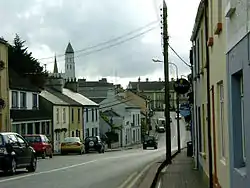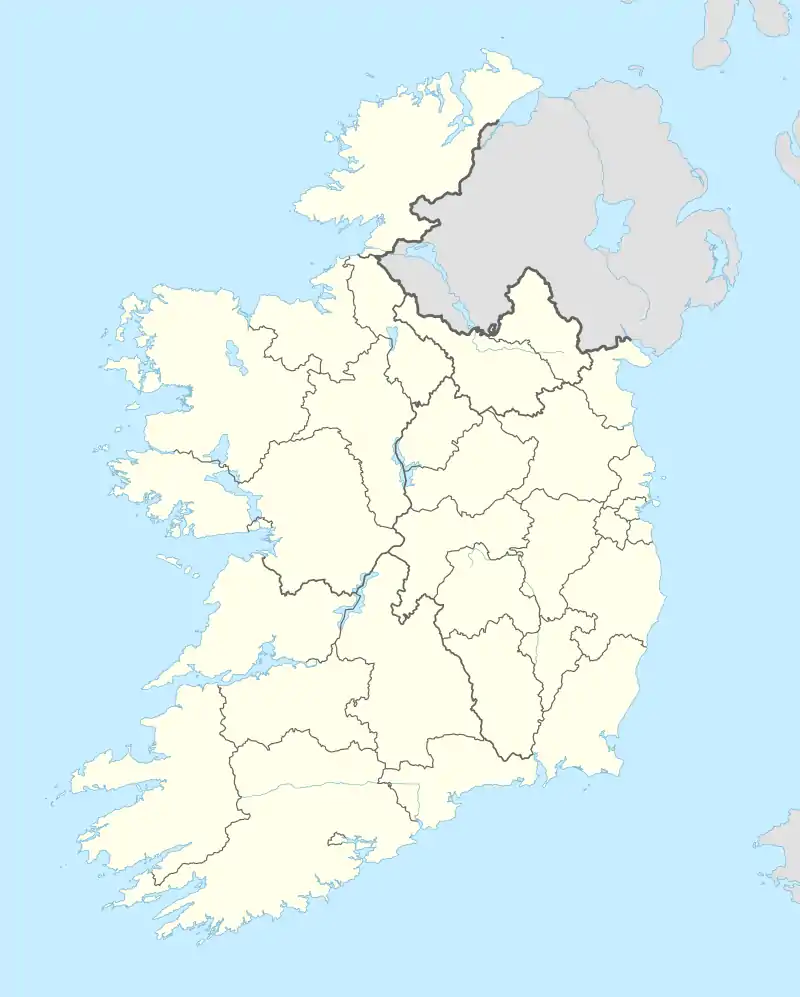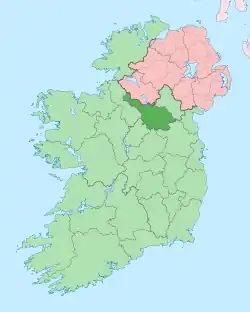Belturbet
Belturbet (Irish: Béal Tairbirt, meaning "mouth of the isthmus")[7] is a town in County Cavan, Ireland. It lies on the N3 road, around 14 km (8.7 mi) north of Cavan town and 123 km (76 mi) from Dublin. It is also located around 4 km (2.5 mi) south of the border with Northern Ireland, between the counties of Cavan and Fermanagh, and 36 km (22 mi) from Enniskillen.
Belturbet
Béal Tairbirt | |
|---|---|
Town | |
 Main Street | |
 Belturbet Location in Ireland | |
| Coordinates: 54°06′N 7°27′W | |
| Country | Republic of Ireland |
| Province | Ulster |
| County | County Cavan |
| Elevation | 57 m (187 ft) |
| Population (2016)[1] | 1,369 |
| Eircode routing key | H14 |
| Telephone area code | +353(0)49 |
| Irish Grid Reference | H361168 |
| Year | Pop. | ±% |
|---|---|---|
| 1821 | 2,010 | — |
| 1831 | 2,026 | +0.8% |
| 1841 | 2,070 | +2.2% |
| 1851 | 2,054 | −0.8% |
| 1861 | 1,789 | −12.9% |
| 1871 | 1,759 | −1.7% |
| 1881 | 1,807 | +2.7% |
| 1891 | 1,675 | −7.3% |
| 1901 | 1,587 | −5.3% |
| 1911 | 1,371 | −13.6% |
| 1926 | 1,307 | −4.7% |
| 1936 | 1,341 | +2.6% |
| 1946 | 1,179 | −12.1% |
| 1951 | 1,152 | −2.3% |
| 1956 | 1,176 | +2.1% |
| 1961 | 1,093 | −7.1% |
| 1966 | 1,100 | +0.6% |
| 1971 | 1,092 | −0.7% |
| 1981 | 1,138 | +4.2% |
| 1986 | 1,228 | +7.9% |
| 1991 | 1,223 | −0.4% |
| 1996 | 1,248 | +2.0% |
| 2002 | 1,295 | +3.8% |
| 2006 | 1,411 | +9.0% |
| 2011 | 1,407 | −0.3% |
| 2016 | 1,369 | −2.7% |
| [1][2][3][4][5][6] | ||
History
Belturbet's location is historically one of the best places for crossing the River Erne. It was the capital of the Kingdom of East Breifne which was an historic kingdom of Ireland roughly corresponding to County Cavan that existed from 1256 to 1607. When the Anglo-Normans tried to conquer Cavan in the early 13th century, Walter de Lacy built a motte-and-bailey on Turbet Island. The fort was probably made of wood and has not survived, although the steep mound of earth where it was built can still be seen. In the late 16th century the local O'Reilly chieftains built a castle opposite Turbot Island, but this has not survived either.
As part of the Plantation of Ulster in the early 17th century, the lands around Belturbet were granted to the English "undertaker" Stephen Butler. He soon established a thriving urban centre, whose prosperity relied heavily on its position on the Erne. The town was seized by the Irish during the Irish Rebellion of 1641, and was the site of one of the massacres of planters, in which over two dozen people were thrown from the town's bridge and drowned. In March 1653, under Viscount Magennis of Iveagh, it was the last town in Ireland to fall to Cromwell; the final Irish stronghold at nearby Cloughoughter held out for a further month.[8]
The town also acquired an English garrison in the late 17th century. Many of the original fortifications are in good repair. Belturbet retains much of its original layout. The main street leads to the square or 'diamond' where all of the town's important buildings are situated. The Church of Ireland church dominates the skyline; some of it dates from the early 17th century, and it was one of the first Anglican churches built in Ireland, reputedly using materials from Drumlane Abbey. The proto-Quaker leader, William Edmundson, was detained in Belturbet in the 1650s, and put in the stocks.[9] The church was damaged by lightning in the 1720s.
Belturbet was represented in the Irish House of Commons from 1611 to 1800. Between 1725 and 1793 Catholics and those married to Catholics could not vote.
John Wesley passed through in 1760, and noted[10]
a town in which there is neither Papist nor Presbyterian; but, to supply that defect there are, Sabbath-breakers, drunkards, and common swearers in abundance.
Two young people, Geraldine O'Reilly, from Staghall, Belturbet, and Patrick Stanley, from Clara, County Offaly, were killed by a Loyalist car bomb in Belturbet on 28 December 1972.[11]
Education
The town has three primary schools, including St. Mary's BNS (a male primary school for second class up to sixth class),[12] Fairgreen National School (a mixed-gender Church of Ireland school,[13] and Covent of Mercy National School (educating boys up to first class and girls up to sixth class).[14]
The town's only secondary school is St Bricins Vocational School, a vocational school run by County Cavan VEC.[15]
Transport
Rail transport
The railway station in Belturbet has recently been restored and is back to its former glory. It was opened on 29 June 1885 for the Great Northern Railway (Ireland) connecting to the broad gauge branch to Ballyhaise railway station on the Clones to Cavan line. It also served the narrow gauge Cavan and Leitrim Railway to Dromod and Arigna, for which it opened on 24 October 1887. The station finally closed for all services on 1 April 1959.[16][17]
Belturbet railway station is a railway museum.
Coach/ bus transport
Bus Éireann Expressway Route 30, jointly operated with McGeehan Coaches. This bus route links Dublin with Donegal providing several stops per day. This bus runs several times daily.[18] Also, Ulsterbus Route 58 from Enniskillen has its terminus in the town. The bus stop is located outside the former post office on the Diamond (for Cavan/Dublin-bound services it is on the opposite side of the road). Leydons Coaches operate route 930 linking the town to Cavan, Ballyconnell, Bawnboy, Swanlinbar and Enniskillen.[19]
Economy
Economic contributors to the town include its retail, service and tourist industries.[23] There is a business park to the north east of the town and smaller employers within the town itself.[24] Tourism facilities include fishing, boat cruising, the local railway station and country walks. The town has its own festival, Belturbet Festival Of The Erne, which also includes the Lady Of the Erne competition. Employment for most of the locals is in Cavan town, Ballyconnell or other nearby areas. The town has a farmers mart every Friday afternoon.
Sport
Belturbet has a local GAA club, Belturbet Rory O'Moores.
Arts
The Erne Palais Ballroom is one of the buildings in the town listed by the National Inventory of Architectural Heritage.[25]
From 1893 to 1931, Shan Fadh Bullock wrote 14 novels set in the Cavan-Fermanagh borderland, renaming Belturbet "Bunn" for his books.[26] Belturbet is also mentioned in James Joyce's 1922 novel Ulysses, in the fifteenth episode, Circe. The reference comes from Cissy Caffrey, who says: 'More luck to me. Cavan, Cootehill and Belturbet'.
Notable people
- Brendan Perry (b.1959), composer and singer with Dead Can Dance, lives in the vicinity of the town.
- James Somers (1894–1918), soldier who won the Victoria Cross during the First World War was from Belturbet.
- Andrew Grene (1965–2010), a civil affairs officer with the United Nations, grew up largely on a small farm outside Belturbet. He was killed in the Haiti earthquake of January 12, 2010, and was laid to rest in Belturbet churchyard.
References
- "Census 2016 Sapmap Area: Settlements Belturbet". Central Statistics Office (Ireland). Retrieved 17 March 2019.
- Census for post 1821 figures.
- http://www.histpop.org Archived 2016-05-07 at the Wayback Machine
- "Archived copy". Archived from the original on 17 February 2012. Retrieved 3 November 2011.CS1 maint: archived copy as title (link)
- Lee, JJ (1981). "On the accuracy of the Pre-famine Irish censuses". In Goldstrom, J. M.; Clarkson, L. A. (eds.). Irish Population, Economy, and Society: Essays in Honour of the Late K. H. Connell. Oxford, England: Clarendon Press.
- Mokyr, Joel; O Grada, Cormac (November 1984). "New Developments in Irish Population History, 1700-1850". The Economic History Review. Volume. 37 (4): 473–488. doi:10.1111/j.1468-0289.1984.tb00344.x. hdl:10197/1406. Archived from the original on 4 December 2012.
- Placenames Database of Ireland
- Pádraig Lenihan, ‘Magennis, Arthur, third Viscount Magennis of Iveagh (1623/1626–1683)’, Oxford Dictionary of National Biography, Oxford University Press, 2004
- Richard L. Greaves, ‘Edmundson, William (1627–1712)’, Oxford Dictionary of National Biography, Oxford University Press, 2004; online edn, Sept 2010
- Wesley, John: The Journal from 6 May 1760, to 28 October 1762
- "Children of Ireland". Archived from the original on 1 October 2018. Retrieved 18 July 2007.
- https://web.archive.org/web/20130315025706/http://www.schooldays.ie/school/s-n-mhuire-rollnumber-18127A
- https://web.archive.org/web/20130315025248/http://www.schooldays.ie/school/fairgreen-n-s-rollnumber-13271F
- https://web.archive.org/web/20130315025643/http://www.schooldays.ie/school/convent-of-mercy-n-s-rollnumber-16057S
- http://www.cavanvec.ie/StBricinsCollege/Pages/Default.aspx
- "Belturbet station" (PDF). Railscot - Irish Railways. Archived (PDF) from the original on 26 September 2007. Retrieved 12 September 2007.
- Baker, Michael HC (1999). Irish Narrow Gauge Railways. A View from the Past. Ian Allan Publishing. ISBN 0-7110-2680-7.
- "Bus Éireann Timetables" (PDF). Archived from the original (PDF) on 1 December 2016.
- "Archived copy". Archived from the original on 8 June 2013. Retrieved 14 February 2013.CS1 maint: archived copy as title (link)
- "Archived copy". Archived from the original on 2 April 2015. Retrieved 4 August 2013.CS1 maint: archived copy as title (link)
- http://www.anglocelt.ie/news/breakingnews/articles/2013/08/02/4016992-belturbet-bypass-now-open/
- http://www.merrionstreet.ie/index.php/2013/12/n3-belturbet-bypass-complete-with-opening-of-bridge-2/
- "Belturbet Local Area Plan". County Cavan - Consolidated Development Plans (Report). Cavan County Council. 2007.
16.6 Industry, Enterprise and Employment / The service employment sector within Belturbet is essential to the vitality of the town. Employment opportunities within the town exist mainly in the Belturbet Business Park [..] as well as other services provided within the Town Core [..[..] the potential of tourism and leisure sectors [..] produces cumulative economic benefits
- "Belturbet". Cavan County Development Plan 2014-2020 (PDF) (Report). Cavan County Council. 2015. p. 335.
- "Erne Palais Ballroom, Holborn Hill, Belturbet, County Cavan". National Inventory of Architectural Heritage. National Inventory of Architectural Heritage. Retrieved 4 October 2018.CS1 maint: others (link)
- Patrick Maume, ‘Bullock, Shan Fadh (1865–1935)’, Oxford Dictionary of National Biography, Oxford University Press, 2004
External links
| Wikimedia Commons has media related to Belturbet. |

